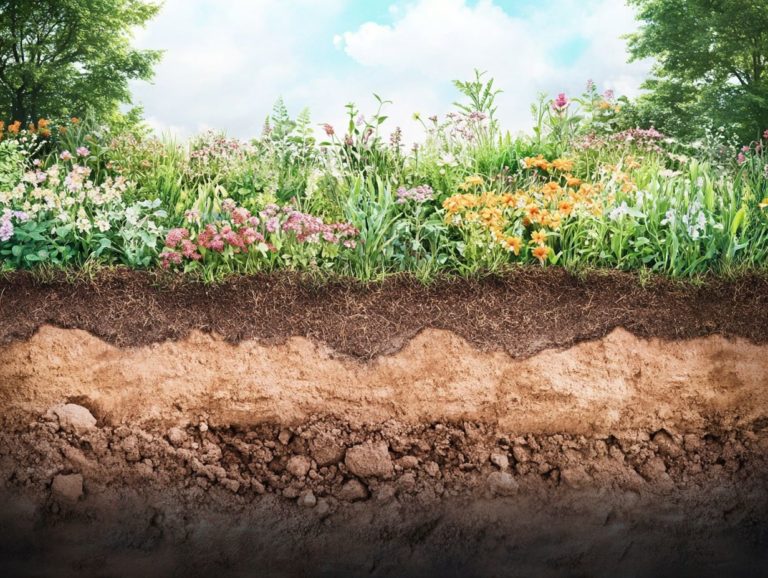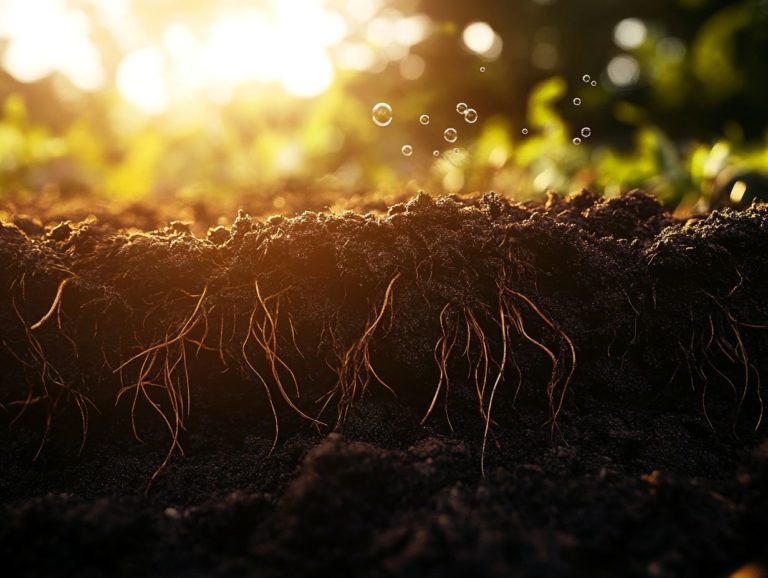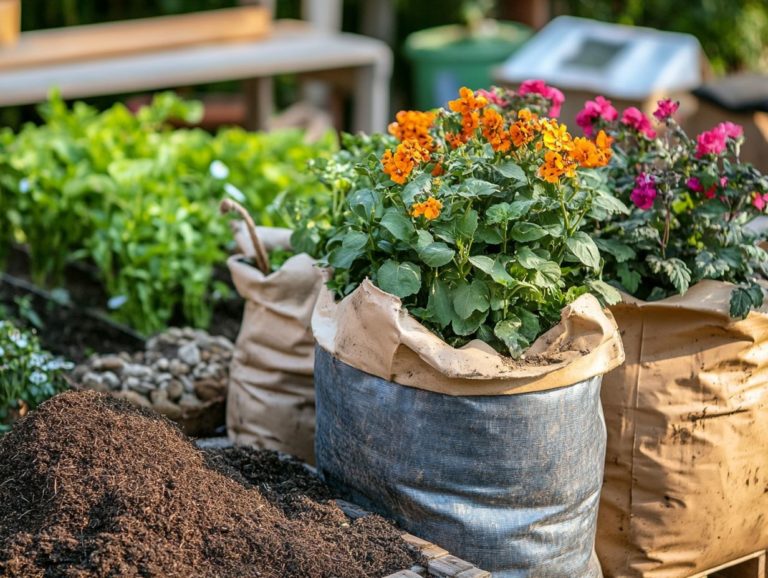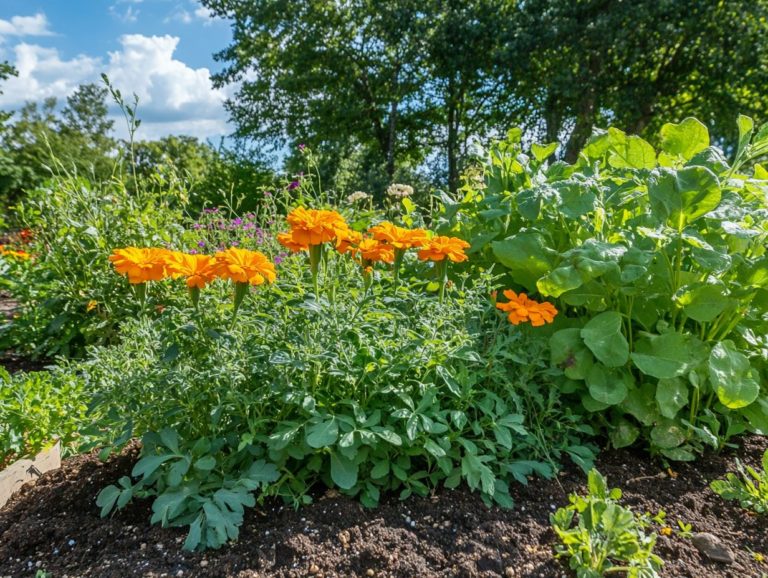How to Use Green Manures Effectively
Green manures are your secret weapon for healthier, more fertile soil! These cover crops do more than enhance nutrients; they fight erosion and keep weeds away.
In this article, you’ll explore the essence of green manures. You’ll discover the many types you can incorporate into your garden and uncover their benefits.
Learn how to select the right green manure for your climate and soil conditions. Practical methods for planting will help you maximize their advantages.
Discover how these green allies can transform your gardening experience while supporting garden charity initiatives!
Contents
- Key Takeaways:
- Understanding Green Manures
- Types of Green Manures
- Benefits of Using Green Manures
- How to Choose the Right Green Manure for Your Garden
- Methods for Incorporating Green Manures into Your Garden
- Want to supercharge your garden? Discover the Benefits of Green Manures!
- Frequently Asked Questions
Key Takeaways:

- Incorporating green manures can improve soil quality and nutrient cycling.
- When choosing a green manure, consider your climate and soil type for optimal results.
- Use proper timing and crop rotation strategies to maximize the benefits of green manures.
Understanding Green Manures
Understanding green manures is crucial for anyone looking to improve their vegetable garden. These fast-growing plants enrich the soil and promote a variety of life.
Using cover crops like phacelia and winter field bean encourages nitrogen fixation. This process helps make essential nutrients available for robust vegetable growth.
Definition and Purpose
Green manures are your fast-growing allies in the garden. They enhance soil structure and boost fertility.
These plants help with nitrogen fixation, replenishing your soil’s nutrients. Adding species like clover or vetch raises nitrogen levels, creating a healthier environment for crops.
Regardless of your gardening conditions be it raised beds, community gardens, or large fields you can use various green manures. For instance, winter rye thrives in cooler climates, while buckwheat flourishes in warmer months.
Types of Green Manures
You ll find various green manures, including legumes and grasses, each playing a distinct role in the garden ecosystem. Legumes like alfalfa and Crimson Clover are valued for their nitrogen-fixing capabilities.
Grasses and cover crops like mustard and buckwheat improve soil structure and suppress weeds. Embracing these options elevates the health and vitality of your garden.
Benefits of Using Green Manures

The advantages of using green manures are substantial! They enhance soil quality and nutrient cycling, making them an essential asset for any gardener aiming to boost their vegetable yields.
Green manures prevent soil erosion and improve soil structure. They help suppress weeds and enrich the soil with vital organic matter. This helps create healthier crops for spring planting.
Soil Improvement and Nutrient Cycling
Soil improvement and nutrient cycling elevate your soil’s fertility and structure to new heights.
These cover crops are often cultivated during off-seasons and play a pivotal role in enriching the soil with organic matter. They enhance the overall structure and boost moisture retention and aeration, creating an ideal environment for growth.
As the green manures decompose, they release vital nutrients like nitrogen and phosphorus, essential for the thriving plants that follow.
Introducing these crops stimulates beneficial soil microbes, breaking down organic materials and fostering a vibrant ecosystem. This relationship between plants and soil organisms facilitates a balanced nutrient cycle, leading to healthier and more productive soils.
How to Choose the Right Green Manure for Your Garden
Choosing the right green manure can transform your garden! Consider factors like climate, soil type, and your unique gardening objectives. Certain green manures will be more beneficial depending on your region and soil conditions.
For instance, annual legumes like crimson clover or mustard thrive in diverse environments. A well-planned planting schedule is key to your gardening success!
Considerations for Climate and Soil Type
When selecting green manures, prioritize climate and soil type. Different cover crops like annual legumes thrive under specific conditions.
In warm, humid climates, legumes like cowpea and mungbean shine, enriching the soil with nitrogen and boosting fertility. In cooler regions, species such as winter rye or clover adapt beautifully, providing essential ground cover and preventing soil erosion.
If you re dealing with sandy soils, deep-rooted green manures like sorghum-sudan grass enhance moisture retention. Meanwhile, in clayey soils, crops like buckwheat break up those compacted layers.
By understanding how specific green manures interact with various climatic zones and soil conditions, you can easily tackle soil deficiencies in your garden today!
Methods for Incorporating Green Manures into Your Garden
Incorporating green manures into your garden offers various effective methods, from precise planting techniques to digging in lush green foliage. These methods enhance soil structure and improve soil nutrients.
Practices like winter grazing allow you to manage cover crops with finesse, ensuring maximum benefits for your soil’s health and vitality, while enhancing the overall garden ecosystem.
Planting and Incorporation Techniques

Effective planting and incorporation techniques are crucial for maximizing the benefits of green manures! Timing is everything; plant green manures before the cooler months to allow them to flourish and enrich the soil as they break down over winter.
Once they ve grown properly, incorporate these plants using methods like tillage (the preparation of soil for growing crops) or mulching. This integrates the green matter into the soil and helps prevent nutrient loss.
These practices significantly impact soil health, improving its structure, aeration, and water retention. By executing a thoughtful green manure strategy, you foster a vibrant ecosystem that elevates organic matter levels and enhances nutrient availability for your future crops.
Want to supercharge your garden? Discover the Benefits of Green Manures!
To truly maximize the benefits of green manures, focus on precise timing and strategic crop rotation. These practices greatly enhance soil fertility and effectively reduce weed pressure, leading to a more productive and sustainable farming experience.
Timing and Crop Rotation Strategies
Timing and crop rotation strategies are vital for elevating the effectiveness of green manures in soil nutrient enhancement. Understanding the optimal timing for planting can significantly impact their capacity to enrich the soil.
For instance, incorporating legumes like clover in the fall helps fix nitrogen levels by early spring, making them a valuable addition for your next crops.
By implementing a rotation system like alternating between corn and soybeans you can disrupt pest cycles while fostering a diverse microbial community in the soil. This method improves nutrient availability and minimizes reliance on synthetic fertilizers, which are man-made fertilizers that can harm the soil. Embracing these practices leads to sustainable farming that nurtures long-term soil health and productivity.
Frequently Asked Questions
What are green manures and why are they used?
Green manures are cover crops specifically grown to be turned into the soil. They boost your soil’s health by improving soil fertility, suppressing weeds, and providing nutrients for future crops, particularly through nitrogen fixation, which is the process where plants help add nitrogen to the soil.
How do I choose the right green manure for my garden?

Choosing the right green manure depends on your climate, soil type, and specific goals for your vegetable garden. Popular options include legumes like clover and vetch, as well as grasses like rye and oats. You can also consider fast-growing plants like mustard and buckwheat for quicker coverage.
When should I plant green manures?
Typically, plant green manures in the fall after harvesting summer crops. If you have a longer growing season, you can also plant them in the spring. Avoid planting in the summer months to prevent competition with main crops.
How do I incorporate green manures into my garden?
You can incorporate green manures by mowing or cutting them down and tilling them into the soil. Alternatively, let them die off naturally and then plant your next crop on top of the decomposing green manure for added organic matter.
What are the benefits of using green manures?
Green manures have numerous benefits for your garden, including:
- Improving soil structure
- Increasing organic matter
- Fixing nitrogen
- Attracting beneficial insects and pollinators
- Reducing erosion
- Saving money on fertilizers and pesticides
Start using green manures today to see incredible results!
Are there any downsides to using green manures?
Green manures offer many benefits, but they also have some downsides. They can compete with your main crops for nutrients and water.
Some species might become invasive, especially certain legumes. It’s crucial to research and choose the right green manure for your garden needs. Avoid plants that can lead to problems like clubroot, a disease affecting some plants.






